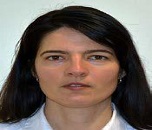Day 14 :
Session Introduction
Kinga Majchrzak
Warsaw University of Life Sciences,Poland
Title: Canine T lymphocytes activation depends on signal strength and temperature

Biography:
Kinga Majchrzak has completed her PhD in 2012 from Warsaw University of Life Sciences (WULS), Poland. She did postdoctoral training at the Medical University of South Carolina, USA. She investigated Th17 lymphocytes in adoptive cell transfer therapy. Currently she is an Associated Professor in Department of Physiological Sciences, WULS. She works on modification of signaling pathways of canine Th17 cells to improve adoptive cellular immunotherapy for humans. She has published 15 papers in the field of immunotherapy and veterinary immunoncology. She is a project leader of the grant FIRST-TEAM from the Foundation for Polish Science financed by the European Union.
Abstract:
Domestic dog is an attractive model for immunological studies. Major subsets of the dog immune system were characterized with significant homology to humans. However, culture of large amounts of canine T cells for the purpose of adoptive cellular immunotherapy still requires optimization. Expansion of T cells in vitro depends on proper activation. In dogs, as well as in humans, stimulation of T lymphocytes engages T-cell receptor (TCR) signal and co-stimulatory signal. Activated T cell up-regulate expression of receptor for interleukin2 (IL2R), the main T cell growth factor.
In our study we used nano-sized magnetic beads coated with anti-canineCD3/anti-canineCD28 to mimic immunological synapse. Canine T lymphocytes were stimulated with beads at either 1:1, 1:2 or 1:0.5 bead:T cell ratio. Our research shown that low-strength activation signal (1:0.5 ratio) caused increased expression of CD25, the alpha chain of IL2R (marker of activation) on canine T cells, 24 and 72h post-stimulation. Lower beads concentration made T lymphocytes to create multiple aggregates, which are the sign of cells activation.
We also determined the impact of temperature range from 330C to 410C on T lymphocytes activation and proliferation. We found that increase of temperature resulted in increased expression of CD25 on T cells. Overall our research revealed the optimal conditions for canine T cells expansion for further immunological assessment and importantly for adoptive T cell transfer, which is a very promising therapy to treat cancer in humans, as well as, in canine patients.
Research funded by the European Union and the Foundation for Polish Science.
Kinga Majchrzak
Warsaw University of Life Sciences,Poland
Title: Canine T lymphocytes activation depends on signal strength and temperature

Biography:
Kinga Majchrzak has completed her PhD in 2012 from Warsaw University of Life Sciences (WULS), Poland. She did postdoctoral training at the Medical University of South Carolina, USA. She investigated Th17 lymphocytes in adoptive cell transfer therapy. Currently she is an Associated Professor in Department of Physiological Sciences, WULS. She works on modification of signaling pathways of canine Th17 cells to improve adoptive cellular immunotherapy for humans. She has published 15 papers in the field of immunotherapy and veterinary immunoncology. She is a project leader of the grant FIRST-TEAM from the Foundation for Polish Science financed by the European Union.
Abstract:
Domestic dog is an attractive model for immunological studies. Major subsets of the dog immune system were characterized with significant homology to humans. However, culture of large amounts of canine T cells for the purpose of adoptive cellular immunotherapy still requires optimization. Expansion of T cells in vitro depends on proper activation. In dogs, as well as in humans, stimulation of T lymphocytes engages T-cell receptor (TCR) signal and co-stimulatory signal. Activated T cell up-regulate expression of receptor for interleukin2 (IL2R), the main T cell growth factor.
In our study we used nano-sized magnetic beads coated with anti-canineCD3/anti-canineCD28 to mimic immunological synapse. Canine T lymphocytes were stimulated with beads at either 1:1, 1:2 or 1:0.5 bead:T cell ratio. Our research shown that low-strength activation signal (1:0.5 ratio) caused increased expression of CD25, the alpha chain of IL2R (marker of activation) on canine T cells, 24 and 72h post-stimulation. Lower beads concentration made T lymphocytes to create multiple aggregates, which are the sign of cells activation.
We also determined the impact of temperature range from 330C to 410C on T lymphocytes activation and proliferation. We found that increase of temperature resulted in increased expression of CD25 on T cells. Overall our research revealed the optimal conditions for canine T cells expansion for further immunological assessment and importantly for adoptive T cell transfer, which is a very promising therapy to treat cancer in humans, as well as, in canine patients.
Research funded by the European Union and the Foundation for Polish Science.
Yacob
Marma Heath Center,Kerala,India
Title: During fever, why our body acts against Facts of Physics?

Biography:
A practicing physician in the field of healthcare in the state of Kerala in India for the last 29 years and very much interested in basic research. My interest is spread across the fever , inflammation and back pain,. I am a writer. I already printed and published nine books in these subjects. I wrote hundreds of articles in various magazines.
After scientific studies for a long time, we have developed a theory, Which proves the temperature of fever is to increase blood circulation. we have developed 8000 affirmative cross checking questions. It can explain all queries related with fever and it considers the messages of the body and the facts of physics
Abstract:
According to the facts of physics, if temperature increases, thermal expansion of an object is positive it will expand and with decrease of temperature it will shrink. Pressure will increase due to increase of temperature.On the contrary, during fever we can see blood vessels and skin are shrunk, pressure decreases, body shivers, sleep increases, motion decreases, inflammation increases, body pain increases, blood circulation decreases, dislike cold substances etc...In fever, the firing rate of Warm sensitive neurons decreases, and the firing rate of
Cold sensitive neurons increases.At the same time if we apply hotness from outside by thermal bag or if we drink hot water, our body acts according to the Facts of Physics- increase of temperature pressure will also increase, expands blood vessels and skin, body sweats, motion will increase , inflammation will decrease , body pain will decrease, blood circulation will increase, like cold substances etc..During fever, why our body acts against Facts of Physics? when disease increases, pressure and temperature will decrease. Blood circulation will decrease due to decrease of pressure. If the essential temperature of the body is going out, essential temperature and pressure will further decrease. This will further endanger the life or action of organ.
when disease increase, it is the sensible and discreet action of brain that tends to act against facts of physics to sustain life or protect organ .There is no way other than this for a sensible and discreet brain to protect the life or organ.We will get a clear answer if we find out the purpose of fever, sensible and discreet action of brain . No medical books clarify this
During fever, if the temperature of fever is not a surplus temperature or if it is not suppose to be eliminated from the body, the shrinking of skin and blood vessels, shivering of body, dislike towards cold substances etc are a protective covering of the body to increase blood circulation to important organs of the body it is against the facts of physics.
Sheila Cabezas
Flinders University,Australia
Title: Dengue virus induced alternative complement pathway dysregulation: contrasting effects on factor B and extracellular factor H production

Biography:
Sheila Cabezas is a PhD student at Flinders University, Adelaide, Australia. She completed her Bachelor degree in Biology at the University of Havana, Cuba and her Master degree in Virology at Tropical Medicine Institute Pedro Kouri, Cuba.
Abstract:
Severe dengue virus (DENV) infection is associated with overactivity of the complement alternative pathway (AP). Here, we investigate the molecular changes in factor H (FH) a major negative regulator of the AP, during DENV infection. FH mRNA is significantly increased in DENV-infected endothelial cells (EC) and macrophages but in contrast production of extracellular or cell surface bound FH protein is not. This phenomenon is not seen for the AP activator, factor B (FB), with DENV induction of both FB mRNA and protein. Further, this is not observed with Toll-like receptor 3 or 4 stimulation of EC and macrophages, which induces both FH mRNA and protein. Intracellular FH protein, however is induced by DENV, but only in DENV antigen-positive cells while in two other DENV-susceptible immortalised cell lines (ARPE-19 and HREC), FH protein is induced both intracellularly and extracellularly by DENV infection. Regardless of the cell type, there is an imbalance in AP components with lower FH relative to FB protein and increased deposition of the complement component C3b on the surface of DENV-infected cells. Mechanistically, IFN-mediated induction of FB and FH mRNA and for FB also protein in EC in a manner consistent with other interferon stimulated genes. This study demonstrates complement dysregulation in DENV-infected EC and macrophages, with increased components that are associated with elevated complement activity such as FB and C3b deposition, without an equivalent increase in the negative regulator, FH . These changes are predicted to result in higher complement activity in the local microenvironment of EC, with the potential to induce functional changes that may result in increased vascular permeability, a hallmark of dengue disease.
Caitlin D. Bohannon
Centers for Disease Control and Prevention, USA
Title: Influenza virus targets innate and adaptive immune cells, suppressing the immune response to homologous and heterologous antigens

Biography:
Caitlin Bohannon received her PhD from Emory University in 2016 and is currently a postdoctoral fellow at the Centers for Disease Control and Prevention in Atlanta, Georgia. She has published several articles and works to expand our currently understanding of the role of adaptive immunity in influenza infection, as well as how the virus evades the immune response.
Abstract:
Influenza is one of the leading causes of morbidity and mortality worldwide, with the WHO estimating around 3 to 5 million serious cases of influenza globally, resulting in 250,000-500,000 deaths annually. Secondary infections further complicate influenza’s morbidity and mortality, and significantly factored into the severity of the 1918 and more recent 2009 pandemics. The most common coinfections are bacterial, leading to bacterial pneumonia, though viral secondary infections may also occur. Previous studies have shown that influenza can target innate responses and damage affected tissues, opening the door for secondary infection. In this study we show that influenza virus targets not only innate immune responses but also the adaptive response - specifically activated B cells, T cells, and NKT cells. Finally, we explored the mechanism by which the virus targets these cells to suppress the immune responses to both homologous and heterologous antigens – potentially leaving the host more susceptible to coinfection.
Joanna K. Bujak
Warsaw University of Life Sciences,Poland
Title: Differential expression of TRPV and TRPM ion channels in the canine PBMC in response to temperature and mitogen treatment.

Biography:
Joanna Bujak has a MSc in Biology from University of Arkansas where she was working on proteins involved in the control of hydro-mineral balance. Currently, she is a PhD student at the Faculty of Veterinary Medicine of Warsaw University of Life Sciences under the supervision of dr Kinga Majchrzak. Joanna’s research focuses on the role of TRP ion channels in modulation of T cells functions. Recently, she was awarded with Polish National Science Center Grant.The research was supported by an National Science Centre Grant 2016/21/N/NZ6/02137.
Abstract:
Movement of ions across lipid bilayer is essential in regulation of cellular functions. Transient Receptor Potential (TRP) ion channels are family of non-specific, cation permeable proteins that might tune the immune response and thus are potential targets for immunomodulation. They act as cellular sensors of temperature, pH, ROS (radical oxygen species), respond to multiple phytochemicals (e.g. capsaicin) and participate in cell-environment crosstalk. TRP ion channels are expressed on immune cells, however the knowledge on their role in immunity is still limited.
The main aim of the study was to evaluate the expression of TRPV and TRPM members in the canine peripheral blood mononuclear cells (cPBMC) and how the expression is affected by temperature or mitogen treatment (Concanavalin A (ConA)).
In silico analysis revealed that canine TRP ion channels are represented by 28 members, grouped into 6 subfamilies. We found the highest mRNA expression of TRPM2, TRPM7 and TRPV2. PBMCs cultured in various temperatures (37°C, 38.5°C and 40°C) exhibit differential expression of TRPV and TRPM. TRPV2 expression was upregulated in response to higher temperature. On the contrary, 40°C downregulated expression of TRPM5. Interestingly, ConA treatment significantly reduced expression of TRP channels. Expression of TRPV1 was downregulated also on protein level when cPBMCs were treated with ConA. The downregulation of TRP channels expression after ConA treatment might protect the cell from activation-induced cell death. The effect of 33°C and 41°C as well as the effect of TRPV1 activator (capsaicin) and antagonist (capsazeine) treatment on T lymphocyte activation is currently under investigation.
Teppei Kitagawa
Beckman Coulter, Japan
Title: Optimization of Cell culturing condition and Cell quality control is Essential for Engineered T-cell Therapy

Biography:
Teppei Kitagawa has expertise in cell biology, cancer biology, and antibody engineering. He acquired the knowledge and technique in research institute of academia and company. His hope for helping many patients suffering from cancer matches Beckman Coulter’s belief and he joined the company.
Beckman Coulter has challenged to improve human health by innovating in Life Science technology and focused on the Immune Therapy. Based on his knowledge concerning antibody medicine and research experience, he has met many researchers to discuss the subjects that they have faced. He and his company’s associates have tried to find the solution for the subjects.
Abstract:
Immune therapy for cancer has started in 1900’s. However the immune system and understanding of their mechanisms were not elucidated so that the therapy couldn’t provide sufficient effect. Recent studies regarding cell biology and immune biology enabled us to design engineered immune cells using gene editing techniques.
Chimeric antigen receptor T cell therapy (CAR-T), one of cell therapies, is the therapy specific for cancer. T-cells derived from patient are engineered to express a synthetic receptor against specific cancer cells. The engineered T-cells are infused back into the patient’s blood stream. These engineered T-cells recognize cancer cells of the patient and trigger immune response.
To operate CAR-T cell therapy, high qualified CAR-T cells are required for effective cancer treatment. Beckman Coulter provides solutions for CAR-T cells manufacturing processes. Our technologies ensure manufacturing high qualified CAR-T cells (e.g. optimization of the cell culturing, controlling cell viability, checking the cell quality, and antigen receptor expression).
We, Beckman Coulter, explains our solution for optimization of making high qualified CAR-T cell in this session.

Biography:
A practicing physician in the field of healthcare in the state of Kerala in India for the last 29 years and very much interested in basic research. My interest is spread across the fever , inflammation and back pain,. I am a writer. I already printed and published nine books in these subjects. I wrote hundreds of articles in various magazines.
After scientific studies for a long time, we have developed a theory, Which proves the temperature of fever is to increase blood circulation. we have developed 8000 affirmative cross checking questions. It can explain all queries related with fever and it considers the messages of the body and the facts of physics
Abstract:
When the disease becomes threat to life or organs blood circulation decreases, Temperature of fever will emerges to increase prevailing blood circulation. And it acts as a protective covering of the body to sustain life.
When blood flow decrease to brain, the patient becomes fainted-delirious .If we try to decreases temperature of fever, the blood circulation will further reduced. Blood circulation never increases without temperature increase. Delirious can never be cured without increase in blood circulation.
The temperature of fever is not a surplus temperature or it is not to be eliminated from the body. During fever, our body temperature increases like a brooding hen`s increased body temperature.
The actual treatment to fever is to increase blood circulation.Two ways to increase blood circulation. 1. Never allow body temperature to lose 2. Apply heat from outside to the body. When the temperature produced by body due to fever and heat which we applied on the body combines together, the blood circulation increases.
Then body will stop to produce heat to increase blood circulation. And body will get extra heat from outside without any usage of energy.
How can we prove that the temperature of fever is to increase blood circulation?
If we ask any type of question related to fever by assuming that the temperature of fever is to increase blood circulation we will get a clear answer. If avoid or evade from this definition we will never get proper answer to even a single question
If we do any type of treatment by assuming that the temperature of fever is to increase blood circulation , the body will accept, at the same time body will resist whatever treatment to decrease blood circulation.
No further evidence is required to prove the temperature of fever is to increase blood circulation.
Adeyemi Abati
Obafemi Awolowo University,Nigeria
Title: Hepatitis c virus testing and treatment among persons receiving buprenorphine in an office -based program for opioid use disorders in Nigeria

Biography:
Dr. Adeyemi Abati completed is Mbbs in 2004 at Obafemi Awolowo University teaching hospital ile –ife Nigeria. He was trained at the department of infectious diseases during his residency and he was able to provide several superior care and consultation that resulted in overall improvement of department patient’s satisfaction quotient.Dr. Adeyemi focused on patient’s treatment and re-evaluated several methods of therapy management dependent on infection types tailored to patient’s individual patient history and efficacy of previous treatments. He latter preceded and completed is master degree in public health at the same Institution. Dr. Adeyemi has then been practicing in department of infectious disease at Lagos university teaching hospital, one of the top tree infection disease hospital in Nigeria and also doing his PhD at the moment .He Adeyemi currently holds a certification from Nigerian board of internal medicine for internal medicine ,hematology and infectious disease and also awarded the ward of the developing leader in medicine from Nigerian medical association in 2010 for his excellent contribution in general treatment and towards the reduction of infectious disease in Nigeria.
Abstract:
Aims: In Nigeria, Hepatitis c virus (Hcv) infection is primarily spread through injection drug use. there is an urgent need to improve access to care for Hcv among persons with opioid use disorders who inject drugs. The purpose of our study was to determine the prevalence of Hcv, patient characteristics, and receipt of appropriate care in a sample of patients treated with buprenorphine for their opioid use disorders in a primary care setting.
Methods: This study used retrospective clinical data from the electronic medical record. the study population included patients receiving buprenorphine in the office based opioid treatment (Obot) clinic within the adult primary medicine clinic at Lagos medical center between October 2008 and august 2015 who received a conclusive Hcv antibody AB test within a year of clinic entry. we compared characteristics by Hcv serostatus using Pearson’s chi-square and provided numbers/percentages receiving appropriate care.
Results: The sample comprised 300 patients. slightly less than half of all patients (n = 134, 27.7%) were Hcv AB positive, and were significantly more likely to be older Hausas and Yoruba’s, have diagnoses of post- traumatic stress disorder (ptsd) and bipolar disorder, have prior heroin or cocaine use, and be hi v- infected. among the 134 Hcv AB positive patients, 126 (67.7%) had detectable Hcv Ribonucleic acid (RNA) indicating chronic Hcv infection; only 8 patients (2.21%) with chronic Hcv infection ever initiated treatment.
Conclusions : Nearly half of patients (47.7%) receiving office-based treatment with buprenorphine for their opioid use disorder had a positive hepatitis c virus antibody screening test, although initiation of Hcv treatment was nearly non-existent (2.21%).
Young-Hoon Joo
Catholic University of Korea, Republic of Korea
Title: Head and Neck Squamous Cancer Stem Cells and Metastasis in vitro and in vivo in the Chick Chorioallantoic Membrane Assay

Biography:
Dr. Joo has completed his MD and PhD in Medical Science /Otolaryngology from The Catholic University of Korea, School of Medicine. He is a professor at Department of Otolaryngology-Head and Neck Surgery, The Catholic University of Korea. He has published more than 50 papers in reputed journals and has been serving as an editorial board member of repute.
Abstract:
Background:To evaluate the impact of CSC proportion on metastasis in head and neck
squamous cell carcinoma (HNSCC) using in vitro and in vivo models.
Method: In vitro motility was assessed using wound healing and matrigel invasion assays. Tumorigenesis and metastasis were assessed in a chick chorioallantoic membrane (CAM) assay.
Results: Flow cytometry demonstrated 60-70% CD44+ cells in UMSCC-110 and 30-40% in UMSCC-106. UMSCC-110 cells demonstrated significantly faster wound closure (p<0.05) and more efficient invasion (p=0.033) compared to UMSCC-106 cells. In the CAM assay, there was a significant difference in liver metastasis between CD44high cells and unsorted or CD44low cells (p=0.027 in UMSCC-110 and p=0.035 in UMSCC-106, respectively).
Conclusion: The proportion of CSC was significantly related to mobility and metastasis in HNSCC cell lines. This concept might help to improve understanding of mechanisms of metastasis and change therapeutic approaches to treating cancer metastasis.
Keywords: Squamous Cell Carcinoma; Head and Neck Neoplasms; Neoplastic Stem Cells; Neoplasm Metastasis; Cell Line
